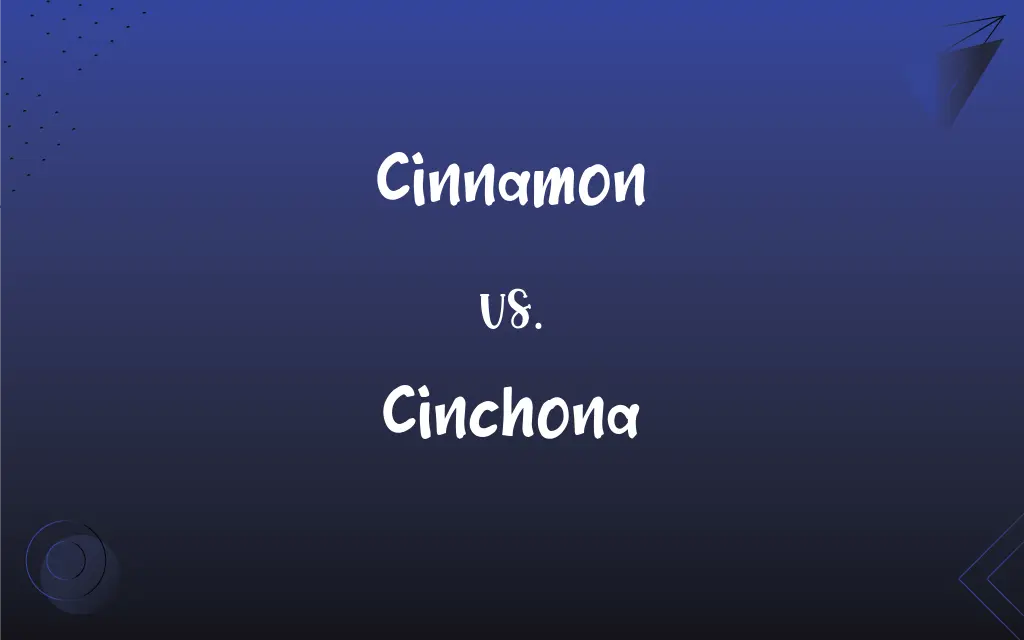Cinnamon vs. Cinchona: What's the Difference?
Edited by Aimie Carlson || By Janet White || Published on December 24, 2023
Cinnamon is a spice from the bark of trees from the Cinnamomum family, used for flavoring, while cinchona is a tree known for its bark that contains quinine, used to treat malaria.

Key Differences
Cinnamon is primarily used as a fragrant spice in various cuisines, derived from the inner bark of Cinnamomum trees. In contrast, cinchona is a genus of medicinal trees, notable for their bark which is the original source of quinine, a drug used to treat malaria.
The cultivation of cinnamon is widespread in tropical regions, with a rich history in spice trade. On the other hand, cinchona trees, native to South America, were historically cultivated for their medicinal value, particularly in the prevention and treatment of malaria.
Cinnamon has a sweet and woody flavor, making it popular in both sweet and savory dishes. In contrast, cinchona bark has a bitter taste, and its extract is used in pharmaceuticals and sometimes in tonic water.
The health benefits of cinnamon include anti-inflammatory properties and blood sugar regulation, while cinchona bark is valued for its antimalarial properties due to the presence of quinine.
Cinnamon is often found in ground form or as cinnamon sticks in culinary uses. Meanwhile, cinchona bark is typically processed into extracts or powders for medicinal use.
ADVERTISEMENT
Comparison Chart
Source
Bark of Cinnamomum trees
Bark of Cinchona trees
Primary Use
Spice in cooking
Source of quinine for treating malaria
Flavor
Sweet, woody
Bitter
Cultivation Regions
Tropical areas worldwide
Originally from South America
Form
Ground spice or sticks
Extracts, powders for medicinal use
ADVERTISEMENT
Historical Significance
Valued in ancient spice trade
Important in the history of medicine for malaria treatment
Cinnamon and Cinchona Definitions
Cinnamon
A natural preservative due to its antimicrobial properties.
Cinnamon is used as a preservative in traditional pickling.
Cinchona
A symbol of colonial medicine due to its role in treating tropical diseases.
Cinchona plantations were established in colonial territories.
Cinnamon
A warm brown color resembling the spice.
The cinnamon-colored sofa complemented the room's decor.
Cinchona
An ingredient in tonic water, providing a characteristic bitter taste.
Tonic water contains a small amount of cinchona extract.
Cinnamon
The aromatic bark used in stick form as a spice.
He added a cinnamon stick to the mulled wine.
Cinchona
A tree whose bark is used to extract quinine, an antimalarial drug.
Cinchona bark was historically significant in treating malaria.
Cinnamon
A fragrant spice obtained from the bark of certain trees, used in sweet and savory dishes.
She sprinkled cinnamon on her oatmeal.
Cinchona
A genus of flowering plants in the Rubiaceae family, native to South America.
The cinchona tree is indigenous to the Andean forests.
Cinnamon
A symbol of exotic spice trade in history.
Cinnamon was once a highly prized commodity in Europe.
Cinchona
A medicinal plant with a bitter bark used in pharmaceuticals.
The bitter cinchona bark is ground into powder for medical use.
Cinnamon
The dried aromatic inner bark of certain tropical Asian trees of the genus Cinnamomum, especially C. verum and cassia (C. aromaticum), often ground and used as a spice.
Cinchona
Any of various evergreen trees and shrubs of the genus Cinchona, native chiefly to the Andes, some species of which are cultivated for their bark, which contains quinine and other alkaloids used chiefly to treat malaria.
Cinchona
The dried bark of any of these plants. Also called Jesuit's bark, Peruvian bark.
Cinchona
A tree or shrub of the genus Cinchona, native to the Andes in South America but since widely cultivated in Indonesia and India as well for its medicinal bark.
Cinchona
The bark of these plants, which yield quinine and other alkaloids useful in reducing fevers and particularly in combatting malaria.
Cinchona
(medicine) Any medicine chiefly composed of the prepared bark of these plants.
Cinchona
A genus of trees growing naturally on the Andes in Peru and adjacent countries, but now cultivated in the East Indies, producing a medicinal bark of great value.
Cinchona
The bark of any species of Cinchona containing three per cent. or more of bitter febrifuge alkaloids; Peruvian bark; Jesuits' bark.
Cinchona
Any of several trees of the genus Cinchona
FAQs
Where is cinnamon commonly used?
In cooking, for both sweet and savory dishes.
What is cinnamon?
A spice from the bark of Cinnamomum trees.
What does cinchona bark taste like?
Bitter.
Can cinnamon be used medicinally?
Yes, for anti-inflammatory effects and blood sugar regulation.
What is the flavor profile of cinnamon?
Sweet and woody.
Can cinnamon be used as a preservative?
Yes, due to its antimicrobial properties.
Is cinnamon available in different forms?
Yes, as ground spice or cinnamon sticks.
How has cinchona impacted the pharmaceutical industry?
Its quinine content revolutionized malaria treatment.
What is the primary use of cinchona?
To produce quinine, a drug for treating malaria.
Where do cinchona trees grow?
Originally in South America.
Is cinnamon native to a specific region?
It grows in tropical regions worldwide.
What is cinchona?
A tree whose bark is used for extracting quinine.
How did cinnamon influence historical trade?
It was a valuable commodity in ancient spice trade.
What is the color associated with cinnamon?
A warm, brownish color similar to the spice.
What is the historical significance of cinchona?
It was vital in treating malaria, especially in colonial times.
Can cinchona be grown outside of South America?
Yes, it's cultivated in various tropical regions.
Does cinnamon have any cultural significance?
It's a symbol of ancient trade and cultural exchange.
Is cinnamon used in any traditional remedies?
Yes, in various traditional medicine systems for its health benefits.
Is cinchona used in any beverages?
Yes, in tonic water for its bitter taste.
How is cinchona bark processed for medical use?
It's ground into powder or extracted.
About Author
Written by
Janet WhiteJanet White has been an esteemed writer and blogger for Difference Wiki. Holding a Master's degree in Science and Medical Journalism from the prestigious Boston University, she has consistently demonstrated her expertise and passion for her field. When she's not immersed in her work, Janet relishes her time exercising, delving into a good book, and cherishing moments with friends and family.
Edited by
Aimie CarlsonAimie Carlson, holding a master's degree in English literature, is a fervent English language enthusiast. She lends her writing talents to Difference Wiki, a prominent website that specializes in comparisons, offering readers insightful analyses that both captivate and inform.






































































